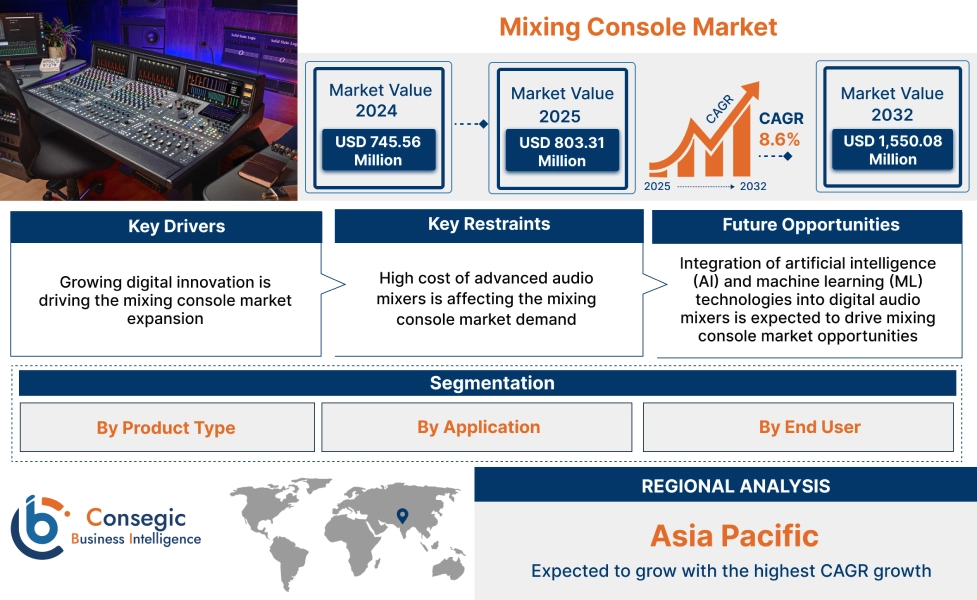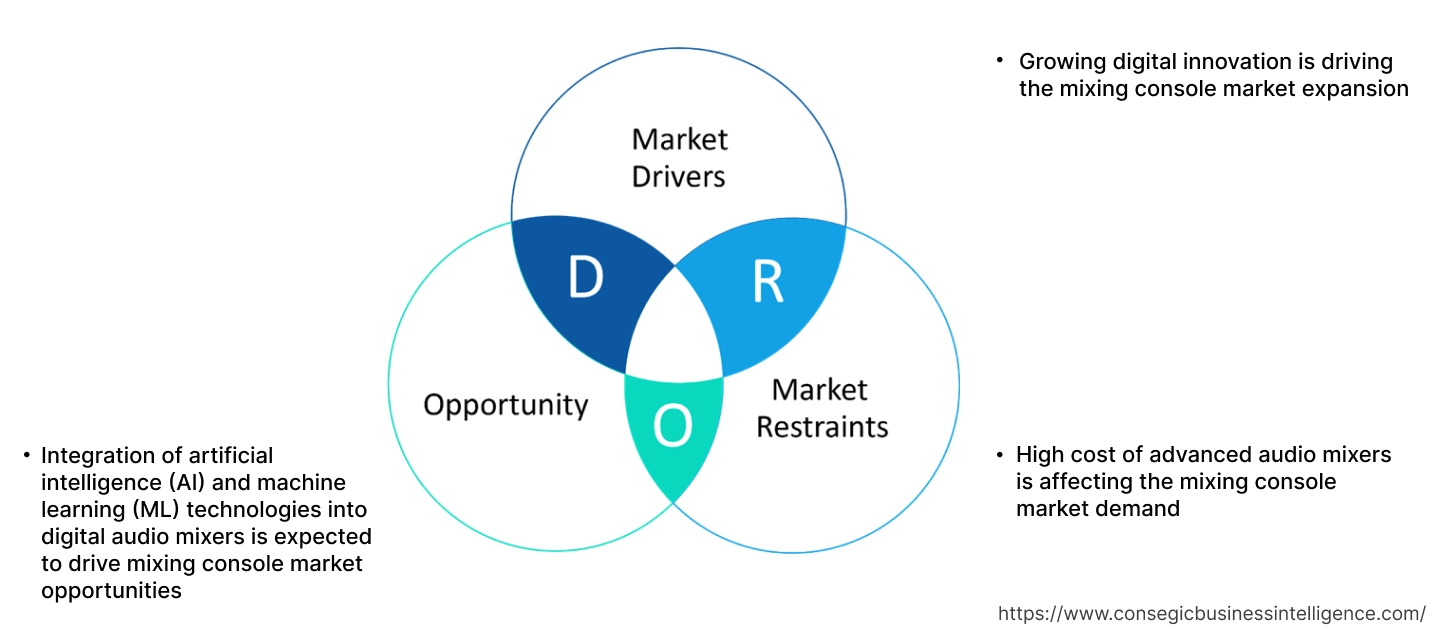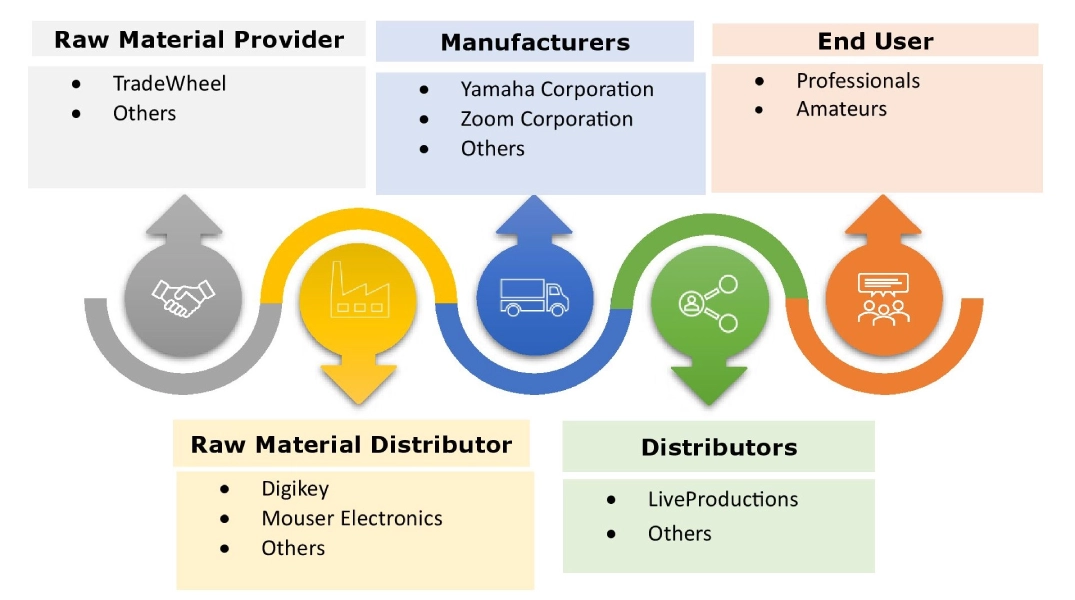Mixing Console Market Size:
Mixing Console Market Size is estimated to reach over USD 1,550.08 Million by 2032 from a value of USD 745.56 Million in 2024 and is projected to grow by USD 803.31 Million in 2025, growing at a CAGR of 8.6% from 2025 to 2032.
Mixing Console Market Scope & Overview:
A mixing console, also known as an audio mixer or mixing desk, is an electronic device used to combine and manipulate multiple audio signals. It enables adjusting levels, tones, and effects of individual audio sources before they are mixed to create a final and combined sound. Professional audio equipment includes high-fidelity sound systems, microphones, amplifiers, mixers, and signal processors used in venues such as concert halls, recording studios, broadcasting facilities, theaters, and corporate events. These technologies are crucial for delivering better sound quality, clarity, and reliability in professional audio production, ensuring immersive auditory experiences for audiences and effective communication in corporate settings.
How is AI Transforming the Mixing Console Market?
Artificial Intelligence is revolutionizing the mixing console market by enhancing sound quality, workflow automation, and user experience. AI-powered mixing consoles can automatically adjust levels, equalization, and effects based on the audio environment, reducing manual intervention and improving consistency. Machine learning algorithms analyze sound patterns to optimize mixing for live performances, studios, and broadcasting applications. AI also enables real-time feedback suppression, noise reduction, and intelligent audio balancing, delivering professional-quality results even for non-expert users. In addition, AI-driven analytics help sound engineers recall preferred settings and predict equipment issues before they occur. As demand for smart audio solutions grows, AI is making mixing consoles more intuitive, efficient, and adaptable across entertainment and production industries.
Mixing Console Market Dynamics - (DRO) :
Key Drivers:
Growing digital innovation is driving the mixing console market expansion
Digital innovation is transforming the global market, driving advancements across various segments and transforming how audio is captured, processed, and reproduced. Digital signal processing (DSP) enhances the capabilities of microphones, mixers, amplifiers, and audio processors by enabling real-time adjustments to sound quality, noise reduction, and spatial effects. This innovation allows professionals in music production, broadcasting, and live events to achieve precise control over audio parameters, delivering clear and immersive sound experiences.
Further, digitalization has revolutionized the landscape, allowing more sophisticated, compact, and user-friendly designs. The transition from analog to digital audio mixers has provided audio engineers with increased flexibility, greater control, and the ability to produce higher quality sound. These advancements are particularly beneficial in live sound environments where precision and reliability are paramount.
- For instance, in November 2024, Yamaha showcased a new range of digital mixing systems, DM7 series, at the Messe Vienna. The digital mixing solutions are suitable for every type of theatre application.
Thus, according to the mixing console market analysis, the growing digital innovation is driving the mixing console market size and growth.
Key Restraints:
High cost of advanced audio mixers is affecting the mixing console market demand
One of the primary challenges associated with the market includes the high cost of advanced digital mixers, which may limit the adoption among amateur users and smaller studios. Modern digital consoles often incorporate digital audio networking protocols such as Dante or AES67 for seamless integration with other audio equipment. Implementing these technologies adds to the development and manufacturing costs. Further, consoles designed for high-end recording studios, broadcast facilities, or large live sound venues are typically more expensive due to the demanding requirements of these applications. Thus, the aforementioned factors would further impact the mixing console market size.
Future Opportunities :
Integration of artificial intelligence (AI) and machine learning (ML) technologies into digital audio mixers is expected to drive mixing console market opportunities
AI and ML can enhance the capabilities of these consoles by providing automated mixing, real-time audio analysis, and adaptive sound processing. These advanced features can help sound engineers achieve better results more efficiently, making digital audio consoles even more attractive to professional users. Manufacturers that invest in developing AI-driven audio mixing solutions can gain a competitive edge and fulfil the growing need for smart and intelligent audio equipment.
- For instance, ATEN’s AI audio mixer, MicLIVE, simplifies audio mixing workflow for podcasting, while offering DSP, 6-channel audio inputs, and an AD/DA converter. This audio mixer utilizes artificial intelligence to automatically enhance microphone sound quality. Its advanced acoustic models and SmartEQ technology ensure anyone can easily achieve professional-level recordings in real time.
Thus, based on the above mixing console market analysis, the integration of artificial intelligence (AI) and machine learning (ML) technologies into digital audio consoles is expected to drive the mixing console market opportunities and growth.
Mixing Console Market Segmental Analysis :
By Product Type:
Based on product type, the market is segmented into digital and analog.
Trends in the product type:
- The segment is expected to see a steady increase in the need for digital consoles, driven by continuous technological advancements and growing user expectations.
- Mixers are gaining popularity among users who seek a balanced approach to sound mixing, providing both tactile control of analog consoles and the precision of digital consoles.
- Thus, based on the above analysis, these factors are driving the mixing console market demand and trends.
The analog segment accounted for the largest revenue share in the year 2024.
- Analog consoles, though traditional, continue to be preferred by some professionals for their warm sound quality and simplicity.
- Analog consoles are often preferred in settings where a classic audio character is desired, such as in certain music genres and smaller studios.
- These consoles are preferred choices for smaller studios and amateur users who appreciate the concrete feedback and simplicity of analog systems.
- For instance, Allen & Heath’s MixWizard series are rack-mountable multi-purpose analog mixers, which are designed for house of worship, rental companies, live venues, broadcasters, and rehearsal studios.
- Thus, based on the above analysis, these factors are further driving the mixing console market growth and trends.
The digital segment is anticipated to register the fastest CAGR during the forecast period.
- Digital consoles have seen significant adoption due to their versatility, compact design, and advanced functionalities.
- These consoles offer features including preset recall, automation, and integrated effects, which are essential for modern audio production environments.
- The ability to easily integrate with other digital audio equipment and software makes digital consoles highly desirable in both studio and live sound settings.
- Moreover, the continual advancements in digital signal processing (DSP) technology further enhance their capabilities, making them the preferred choice in many applications.
- For instance, DigiCo’s digital mixing console, Quantum 852, is a dual-engine and 384-mixer, which includes LCD high-resolution touchscreens.
- Thus, based on the above analysis and developments, these factors are expected to drive the mixing console market share and growth during the forecast period.
By Application:
Based on the application, the mixing console market is segmented into broadcasting, live sound, studio recording, post production, and others.
Trends in the application:
- The development of the entertainment industry and increasing production of high-quality content are driving the adoption of digital audio mixers.
- Manufacturers are developing entry-level and mid-range consoles that offer advanced features at affordable prices, making them accessible to a broader audience. As a result, the segment is witnessing a surge in the adoption of audio mixers among several applications, further driving the market trends.
The broadcasting segment accounted for the largest revenue share of 40.45% in the year 2024.
- In the broadcast sector, the need for high-quality audio mixers is driven by the need to deliver clear and precise audio for television, radio, and online streaming platforms.
- Broadcast environments require reliable and versatile equipment that can handle various audio sources and ensure seamless integration with other broadcast systems.
- As the consumption of media content continues to rise, the need for advanced audio mixers in this sector is expected to grow.
- For instance, Yamaha’s DM7 compact audio mixer is used in broadcasting applications, which is used for mixing 72 channels. The optional broadcast package allows the user to use mix-minus functionality and help in monitoring with a loudness meter.
- Thus, based on the above analysis, these factors would further supplement the mixing console market
The live sound segment is anticipated to register the fastest CAGR during the forecast period.
- The growing number of concerts, music festivals, and live events has created a high need for reliable and high-performance digital consoles.
- Digital consoles are particularly favoured in live sound settings due to their ability to handle complex audio setups and provide precise sound control.
- The ability to remotely control digital consoles through smartphones and tablets also adds to their appeal in live sound applications.
- The growing number of live events worldwide, combined with the increasing expectations for superior sound quality, drives the demand in this segment.
- These developments in the segment are anticipated to further drive the mixing consolemarket trends during the forecast period.
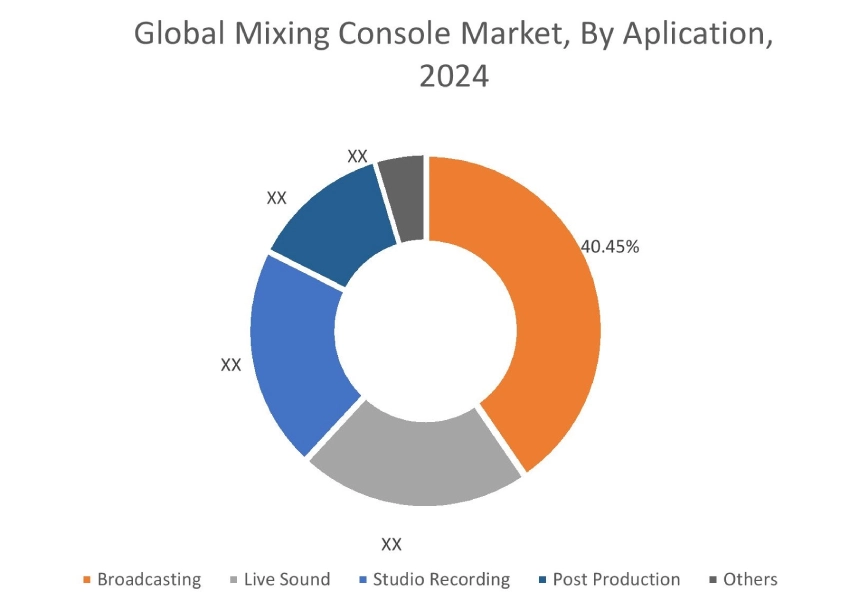
By End User:
Based on end user, the market is segmented into professional and amateur.
Trends in the end user:
- The increasing number of live events and rising expectations for high audio quality are driving the adoption of digital audio mixers among professionals.
- Manufacturers are focusing on creating intuitive user interfaces, including touchscreen control and gesture controls, to make digital mixing more accessible to a wider range of users.
The professional segment accounted for the largest revenue share in the year 2024.
- Professional users include recording studios, broadcast companies, live sound engineers, and other entities that require high-end audio equipment for their operations.
- These users require digital mixers that offer advanced features, reliability, and superior sound quality.
- The increasing professionalism in audio production and the need for high-quality output is driving the need for premium mixing consoles among professional users.
- Professional users tend to prefer high-end digital and hybrid consoles for their advanced features and superior sound quality.
- Therefore, the above factors are driving the mixing console market growth and trends.
The amateur segment is anticipated to register the fastest CAGR during the forecast period.
- Amateur users, including home studio owners, independent musicians, and content creators, represent a growing segment in the mixing console market. These users seek affordable yet advanced mixing solutions that can provide professional-grade audio quality.
- The rise of home studios and increasing popularity of independent music production have led to a growing need for digital mixing consoles among amateur users. These consoles offer the necessary tools for amateurs to produce high-quality recordings, making them an attractive option for this segment.
- The availability of user-friendly digital consoles has also made it easier for amateur users to access advanced audio mixing features.
- These factors are anticipated to further drive the mixing console market trends during the forecast period.
Regional Analysis:
The global market has been classified by region into North America, Europe, Asia-Pacific, Middle East & Africa, and Latin America.
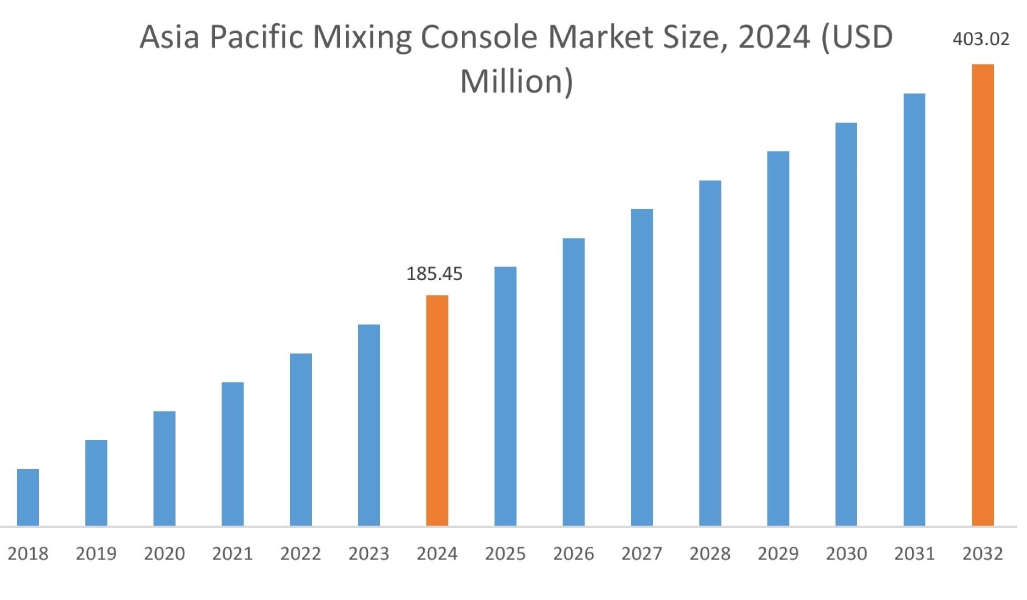
Asia Pacific mixing console market expansion is estimated to reach over USD 403.02 million by 2032 from a value of USD 185.45 million in 2024 and is projected to grow by USD 200.57 million in 2025. Out of this, the China market accounted for the maximum revenue split of 27.78%. The regional growth can be attributed to the increasing investments in entertainment sector, rising number of live events, and the growing popularity of music and media content in emerging economies such as China and India, among others. Further, the region's expanding middle class and increasing disposable incomes are also contributing to the demand for high-quality audio equipment. In addition to this, manufacturers are focusing on expanding their presence in the regional market to capitalize on these growth opportunities. These factors would further drive the regional mixing console market during the forecast period.
- For instance, in March 2022, Yamaha Corporation launched the latest MG-X series of audio mixers to cater to live events and permanent installations that demand top-notch SPX effects. A distinguishing feature of these new models includes the modern grey finish of the master control area, making it easy to spot and adjust crucial settings while seamlessly integrating into any equipment setup.
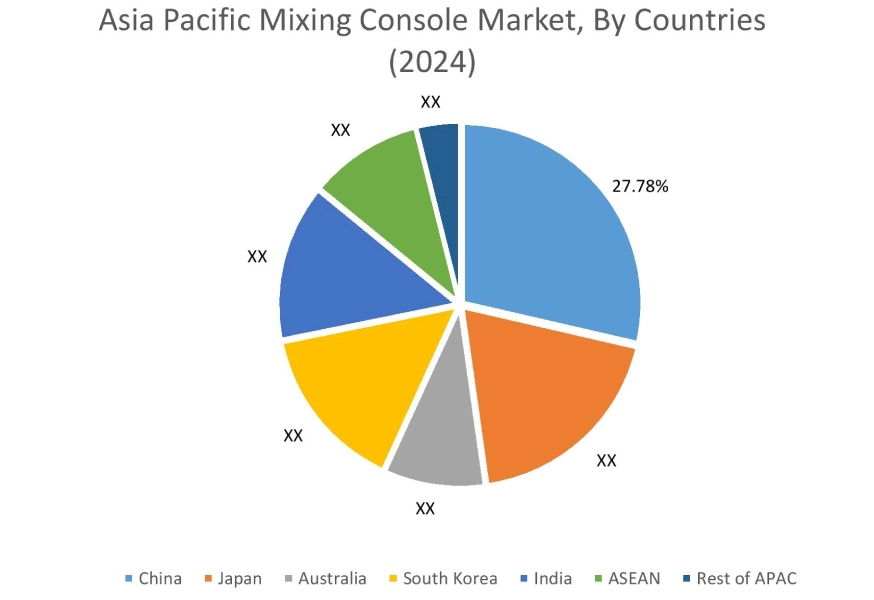
North America market is estimated to reach over USD 599.42 million by 2032 from a value of USD 289.75 million in 2024 and is projected to grow by USD 312.06 million in 2025. North America holds a significant share in the global market, due to the presence of established music and entertainment sectors. The United States is a major market for audio mixers, driven by the high demand for professional-grade audio equipment in studios, live sound events, and broadcasting. Further, the increasing popularity of home studios and independent music production has also contributed to the market development in the region. The region is expected to witness steady growth, with a focus on technological advancements and high-quality sound systems. These factors would further drive the market trends in North America.
- For instance, in October 2023, Harrison Audio introduced a 32Classic mixing console, which features an analog tone, hybrid studio functionality, and flexible workflows. With a hybrid modular design, the console can accommodate a variety of modern and traditional hybrid workflows.
As per the analysis, the mixing console industry in Europe is expected to witness significant development during the forecast period. The increasing use of digital audio workstations and advanced audio equipment in studios and post-production settings is expected to drive the European market development. Additionally, Latin America’s rapid urbanization and digital transformation further accelerate the adoption of advanced audio technologies, including digital mixers, loudspeakers, and wireless microphone s, to meet evolving consumer preferences and industry standards. Further, the emphasis on sound quality, reliability, and advanced audio processing capabilities is driving continuous innovation and adoption of professional audio equipment across various applications in the Middle East & Africa region.
Top Key Players and Market Share Insights:
The global mixing console market is highly competitive, with major players providing products to the national and international markets. Key players are adopting several strategies in research and development (R&D), product innovation, and end-user launches to hold a strong position in the market. Key players in the mixing console industry include-
- Yamaha Corporation (Japan)
- Allen & Heath (U.K.)
- DiGiCo (U.K.)
- Roland Corporation (Japan)
- Zoom Corporation (Japan)
- Soundcraft (Harman International) (U.S.)
- Behringer (Music Tribe) (Philippines)
- PreSonus Audio Electronics (U.S.)
- Avid Technology, Inc. (U.S.)
- TASCAM (TEAC Corporation) (U.S.)
Recent Industry Developments :
Product Launch:
- In June 2024, Cadac Consoles introduced its brand-new CM-series integrated mixing system to the U.S market. The company showcased its new CM-J50 mixing consoles with CM-J software. The updated software includes new functionalities such as console mirroring, console sidecar, and monitor mode.
Mixing Console Market Report Insights :
| Report Attributes | Report Details |
| Study Timeline | 2019-2032 |
| Market Size in 2032 | USD 1,550.08 Million |
| CAGR (2025-2032) | 8.6% |
| By Product Type |
|
| By Application |
|
| By End User |
|
| By Region |
|
| Key Players |
|
| North America | U.S. Canada Mexico |
| Europe | U.K. Germany France Spain Italy Russia Benelux Rest of Europe |
| APAC | China South Korea Japan India Australia ASEAN Rest of Asia-Pacific |
| Middle East and Africa | GCC Turkey South Africa Rest of MEA |
| LATAM | Brazil Argentina Chile Rest of LATAM |
| Report Coverage |
|
Key Questions Answered in the Report
How big is the Mixing Console Market? +
Mixing Console market size is estimated to reach over USD 1,550.08 Million by 2032 from a value of USD 745.56 Million in 2024 and is projected to grow by USD 803.31 Million in 2025, growing at a CAGR of 8.6% from 2025 to 2032.
Which is the fastest-growing region in the Mixing Console Market? +
Asia-Pacific region is experiencing the most rapid growth in the market.
What specific segmentation details are covered in the Mixing Console report? +
The mixing console report includes specific segmentation details for product type, application, end user, and region.
Who are the major players in the Mixing Console Market? +
The key participants in the market are Yamaha Corporation (Japan), Allen & Heath (U.K.), Soundcraft (Harman International) (U.S.), Behringer (Music Tribe) (Philippines), PreSonus Audio Electronics (U.S.), Avid Technology, Inc. (U.S.), TASCAM (TEAC Corporation) (U.S.), DiGiCo (U.K.), Roland Corporation (Japan), Zoom Corporation (Japan), and others.
